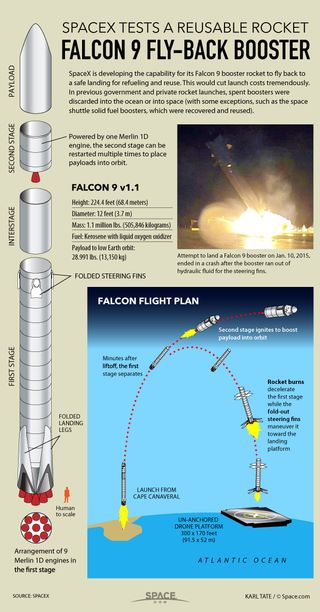Inside SpaceX's Epic Fly-back Reusable Rocket Landing (Infographic)

The private spaceflight company SpaceX will attempt a never-before-attempted reusable rocket landing on an ocean platform with the launch of its Falcon 9 rocket and Dragon spacecraft from Cape Canaveral Air Force Station in Florida on Jan. 6, 2015. Here's how the planned mission will work.
For SpaceX, All Systems 'Go' for Epic Reusable Rocket Landing Test
In a space first, the Falcon 9 rocket first stage used to help launch the Dragon cargo capsule toward the International Space Station will attempt to fly back down and land safely on an offshore floating platform in the Atlantic Ocean. SpaceX had the platform specially built especially for the rocket landing attempt.
After the first stage separates, three separate engine burns put the spent stage on course to re-enter the atmosphere and slow down from 2,900 mph (4,600 km/h) to 4.5 mph (7.2 km/h) at the time of touchdown on an offshore floating platform. The test, which follows two earlier rocket "landings" on the surface of the Atlantic Ocean by SpaceX, is part of the company's program to develop completely reusable rocket technology to lower the cost of spaceflight.
Photos: SpaceX's Amazing Falcon 9 Reusable Rocket
Meanwhile, SpaceX's Dragon spacecraft should continue its mission to deliver 5,200 lbs. (2,360 kilograms) of supplies and gear for 256 scientific experiments on the International Space Station. The mission, called Commercial Resupply Service 5, or CRS-5, will be SpaceX's fifth cargo delivery flight to the station for NASA. SpaceX has a $1.6 billion contract with NASA for 12 such flights using its Dragon spacecraft and Falcon 9 rockets.
- SpaceX Falcon 9 Landing Test Captured By On-Board Cam | Video
- Quiz: How Well Do You Know SpaceX's Dragon Spaceship?
- SpaceX, Dragon Capsule & Falcon 9: Latest News
Follow us @Spacedotcom, Facebook and Google+.
Join our Space Forums to keep talking space on the latest missions, night sky and more! And if you have a news tip, correction or comment, let us know at: community@space.com.
Get the Space.com Newsletter
Breaking space news, the latest updates on rocket launches, skywatching events and more!

Karl's association with Space.com goes back to 2000, when he was hired to produce interactive Flash graphics. From 2010 to 2016, Karl worked as an infographics specialist across all editorial properties of Purch (formerly known as TechMediaNetwork). Before joining Space.com, Karl spent 11 years at the New York headquarters of The Associated Press, creating news graphics for use around the world in newspapers and on the web. He has a degree in graphic design from Louisiana State University and now works as a freelance graphic designer in New York City.
